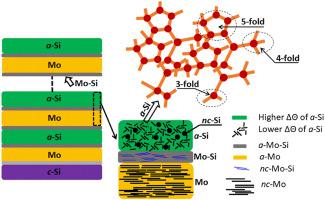当前位置:
X-MOL 学术
›
Intermetallics
›
论文详情
Our official English website, www.x-mol.net, welcomes your
feedback! (Note: you will need to create a separate account there.)
Phase-microstructure of Mo/Si nanoscale multilayer and intermetallic compound formation in interfaces
Intermetallics ( IF 4.3 ) Pub Date : 2020-10-01 , DOI: 10.1016/j.intermet.2020.106872 N. Kumar , A.V. Nezhdanov , R.M. Smertin , V.N. Polkovnikov , P.A. Yunin , S.A. Garakhin , N.I. Chkhalo , A.I. Mashin , M.A. Kudryashov , D.A. Usanov
Intermetallics ( IF 4.3 ) Pub Date : 2020-10-01 , DOI: 10.1016/j.intermet.2020.106872 N. Kumar , A.V. Nezhdanov , R.M. Smertin , V.N. Polkovnikov , P.A. Yunin , S.A. Garakhin , N.I. Chkhalo , A.I. Mashin , M.A. Kudryashov , D.A. Usanov

|
Abstract Microstructural investigation of the Mo/Si nanoscale multilayers (MLs) is essential to design high-reflective nanomirrors. Raman spectroscopy showed existence of silicon layer in the amorphous structure. Small fraction of the nanocrystalline silicon (nc-Si) phase was found to be embedded in the amorphous silicon (a-Si) matrix. The disorder in a-Si is increased with the decrease in the thickness of silicon layer in the Mo/Si MLs, determined by the increased bond-angle deviation (ΔΘ) of the Si–Si network. The MLs exposed to high-temperature (HT) showed a decrease in the ΔΘ value, which signifies the relaxation of both molecular disorder and residual stress. X-ray diffraction analysis confirmed the polycrystalline bcc phase of Mo and the formation of intermetallic t-Mo5Si3 phase in the interfaces. This phase is more prominent for higher value of β (thickness ratio of high atomic weight (z) layer to ML period d, i.e. β = dMo/d). Intensity of the Mo (110) plane is decreased for the sample annealed at HT, which is directly related to the degree of amorphization and the formation of intermetallic phases. However, HT annealed Mo/Si showed the growth of Mo (220) planes for higher β value of MLs. Current findings revealed that the disorder in the a-Si and microstructure of the Mo and intermetallic phase depend on the annealing temperature and the β value. The analysis of the intermetallic phase is critical for the development of high reflective mirrors.
中文翻译:

Mo/Si 纳米级多层的相微观结构和界面中金属间化合物的形成
摘要 Mo/Si 纳米级多层膜 (MLs) 的微观结构研究对于设计高反射纳米镜至关重要。拉曼光谱显示非晶结构中存在硅层。发现小部分纳米晶硅 (nc-Si) 相嵌入在非晶硅 (a-Si) 基质中。a-Si 中的无序随着 Mo/Si MLs 中硅层厚度的减少而增加,这是由 Si-Si 网络的键角偏差(ΔΘ)增加决定的。暴露于高温 (HT) 的 ML 显示出 ΔΘ 值的降低,这表明分子无序和残余应力均得到缓解。X 射线衍射分析证实了 Mo 的多晶 bcc 相和界面中金属间 t-Mo5Si3 相的形成。对于较高的 β 值(高原子量 (z) 层与 ML 周期 d 的厚度比,即 β = dMo/d),该阶段更为突出。高温退火样品的Mo(110)面强度降低,这与非晶化程度和金属间相的形成直接相关。然而,HT 退火的 Mo/Si 显示出 Mo (220) 平面的生长,以获得更高的 MLs β 值。目前的研究结果表明,a-Si 的无序以及 Mo 和金属间相的微观结构取决于退火温度和 β 值。金属间相的分析对于高反射镜的开发至关重要。这与非晶化程度和金属间相的形成直接相关。然而,HT 退火的 Mo/Si 显示出 Mo (220) 平面的生长,以获得更高的 MLs β 值。目前的研究结果表明,a-Si 的无序以及 Mo 和金属间相的微观结构取决于退火温度和 β 值。金属间相的分析对于高反射镜的开发至关重要。这与非晶化程度和金属间相的形成直接相关。然而,HT 退火的 Mo/Si 显示出 Mo (220) 平面的生长,以获得更高的 MLs β 值。目前的研究结果表明,a-Si 的无序以及 Mo 和金属间相的微观结构取决于退火温度和 β 值。金属间相的分析对于高反射镜的开发至关重要。
更新日期:2020-10-01
中文翻译:

Mo/Si 纳米级多层的相微观结构和界面中金属间化合物的形成
摘要 Mo/Si 纳米级多层膜 (MLs) 的微观结构研究对于设计高反射纳米镜至关重要。拉曼光谱显示非晶结构中存在硅层。发现小部分纳米晶硅 (nc-Si) 相嵌入在非晶硅 (a-Si) 基质中。a-Si 中的无序随着 Mo/Si MLs 中硅层厚度的减少而增加,这是由 Si-Si 网络的键角偏差(ΔΘ)增加决定的。暴露于高温 (HT) 的 ML 显示出 ΔΘ 值的降低,这表明分子无序和残余应力均得到缓解。X 射线衍射分析证实了 Mo 的多晶 bcc 相和界面中金属间 t-Mo5Si3 相的形成。对于较高的 β 值(高原子量 (z) 层与 ML 周期 d 的厚度比,即 β = dMo/d),该阶段更为突出。高温退火样品的Mo(110)面强度降低,这与非晶化程度和金属间相的形成直接相关。然而,HT 退火的 Mo/Si 显示出 Mo (220) 平面的生长,以获得更高的 MLs β 值。目前的研究结果表明,a-Si 的无序以及 Mo 和金属间相的微观结构取决于退火温度和 β 值。金属间相的分析对于高反射镜的开发至关重要。这与非晶化程度和金属间相的形成直接相关。然而,HT 退火的 Mo/Si 显示出 Mo (220) 平面的生长,以获得更高的 MLs β 值。目前的研究结果表明,a-Si 的无序以及 Mo 和金属间相的微观结构取决于退火温度和 β 值。金属间相的分析对于高反射镜的开发至关重要。这与非晶化程度和金属间相的形成直接相关。然而,HT 退火的 Mo/Si 显示出 Mo (220) 平面的生长,以获得更高的 MLs β 值。目前的研究结果表明,a-Si 的无序以及 Mo 和金属间相的微观结构取决于退火温度和 β 值。金属间相的分析对于高反射镜的开发至关重要。











































 京公网安备 11010802027423号
京公网安备 11010802027423号